Double knit fabric is a unique type of knitted fabric known for its seamless construction and versatile properties. It is made using two sets of needles set at an angle to each other, resulting in a fabric with identical sides and no visible stitches.
Double knit fabric offers a range of advantages, including stability, durability, and versatility in terms of garment applications. It is commonly used for creating tops, pants, skirts, dresses, jackets, and cardigans, among other clothing items.
The fabric’s medium to heavyweight nature provides good insulation and a polished appearance. While double knit fabric has its advantages, such as its reversible nature and resistance to shrinkage, it also has some considerations to be mindful of, such as potential shape distortion and limited breathability.
By understanding the characteristics and care requirements of double knit fabric, one can fully appreciate its unique qualities and make informed decisions when working with or selecting garments made from this fabric.
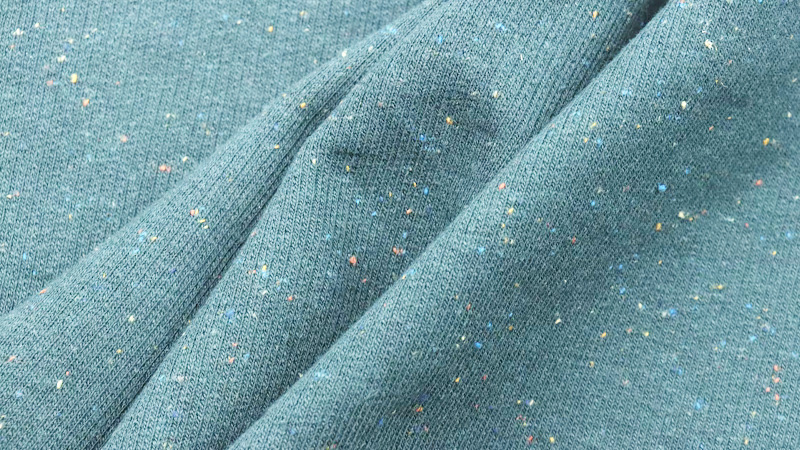
What is Double Knit Fabric?
Double knit fabric is a unique textile where both sides of the fabric exhibit identical characteristics, resulting in a reversible material. This type of fabric is created by interlocking two sets of yarns, typically with a circular knitting machine.
The interlocking structure of the fabric provides it with exceptional stability and a smooth, uniform appearance on both sides. Double knit fabrics are commonly found in variations such as interlock and rib knits.
Interlock knits have a smooth surface and good stretch, while rib knits feature raised vertical lines. These fabrics are often used for creating garments that require a neat finish, durability, and flexibility.
History of Double Knit Fabric
Double knit fabric has a rich history dating back to the late 19th century. It emerged as a response to the increasing demand for more durable and versatile knit fabrics.
The invention of the circular knitting machine and the development of interlock stitch played significant roles in the creation of double knit fabric.
Initially, double knit fabric was primarily made from wool, but with advancements in technology, it expanded to include other fibers like cotton and synthetics.
Its popularity grew in the mid-20th century, and it became a go-to fabric for various garments. Today, double knit fabric continues to be appreciated for its comfort, versatility, and durability.
Characteristics of Double Knit Fabric
Medium to Heavyweight Fabric
Double knit fabric is typically medium to heavyweight, which gives it a substantial feel and excellent durability. This characteristic makes it suitable for creating garments that require structure and resilience.
Versatility
Double knit fabric is highly versatile, making it suitable for a wide range of applications. It can be used to create garments such as dresses, skirts, pants, jackets, and even accessories like hats or bags. Its versatility stems from its ability to accommodate different designs and patterns.
Stable Fabric
Double knit fabric is known for its stability. It has a firm and structured nature, which helps it maintain its shape over time. This stability is attributed to the interlocking structure of the fabric, providing a consistent and reliable fabric base.
Dense
Double knit fabric is dense due to the interlocking of the two sets of yarns. This density contributes to its durability and resistance to wear and tear. It also provides a good level of opacity, making it suitable for garments that require coverage.
Non-curling Edges
Unlike regular knits, double knit fabric does not curl at the edges. This property ensures clean and neat finishing in garments, as the edges remain flat and well-defined.
Reversible
One of the distinguishing features of double knit fabric is its reversibility. Both sides of the fabric look identical, allowing it to be used interchangeably.
This aspect is advantageous when creating reversible garments or items that require a polished appearance from both sides.
Crease Resistant
Double knit fabric tends to be crease resistant, meaning it resists wrinkling and maintains its smooth appearance even after extended wear or storage. This property is particularly beneficial for garments that need to retain their shape and look well-groomed.
Non-shrink
Double knit fabric is generally less prone to shrinking compared to other types of knitted fabrics. This characteristic ensures that the garment’s dimensions remain stable even after washing or exposure to moisture, providing a longer lifespan and a better fit.
Types of Double Knit Fabric
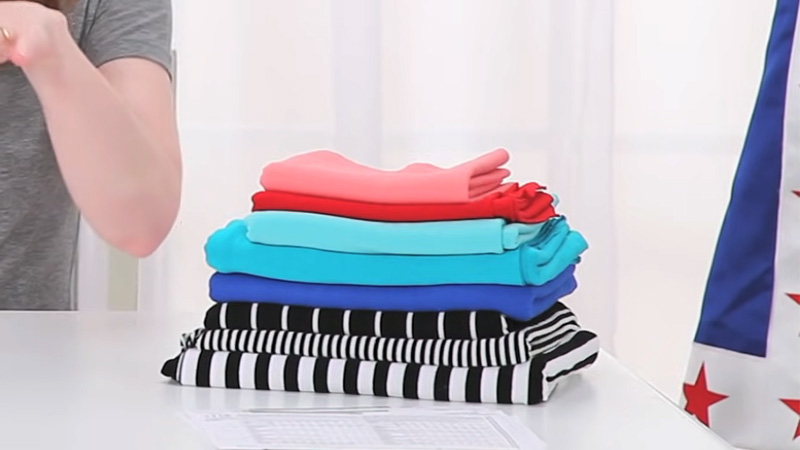
Interlock
Interlock is a popular type of double knit fabric created by interlocking two layers of jersey knit. It results in a smooth, stable, and stretchy fabric with a slight rib-like texture. Interlock is often used for creating comfortable, versatile garments such as T-shirts, dresses, and loungewear.
Ponte Di Roma
Ponte di Roma, also referred to as ponte, is a double knit fabric known for its excellent drape, stability, and substantial weight. It is usually made from a combination of rayon, nylon, and spandex fibers.
Ponte di Roma has a smooth surface, resists wrinkles, and provides moderate stretch. It is commonly utilized in creating structured garments like skirts, pants, blazers, and dresses.
Double Pique
Double pique fabric features a distinctive textured pattern created by alternating raised waffle-like squares or honeycomb motifs. It is thicker and more rigid than other double knit fabrics, often made from cotton or cotton blends.
Double pique is commonly used for sportswear, polo shirts, and casual apparel due to its breathability and textured aesthetic.
Double Jacquard
Double jacquard fabric involves intricate patterns and designs that are woven into the fabric using a double-knit structure. This type of fabric allows for intricate colorwork, complex motifs, and varying textures on both sides. Double jacquard is used in various applications, including high-end fashion, upholstery, and home decor.
Rib Knit
Rib knit is a double knit fabric distinguished by raised vertical lines, or ribs, running along the length of the fabric. It is often used for cuffs, collars, and waistbands due to its elasticity and ability to provide a snug fit. Rib knit is commonly found in T-shirts, sweaters, and other garments that require stretch and recovery.
Milano Knit
Milano knit, also known as Milanese knit, is a double knit fabric characterized by its dense, finely woven structure. It is usually made from a combination of viscose, nylon, and spandex fibers.
Milano knit offers excellent shape retention, moderate stretch, and a smooth, polished appearance. It is often used for creating tailored garments like skirts, dresses, and jackets.
What is Double Knit Fabric Made of ?
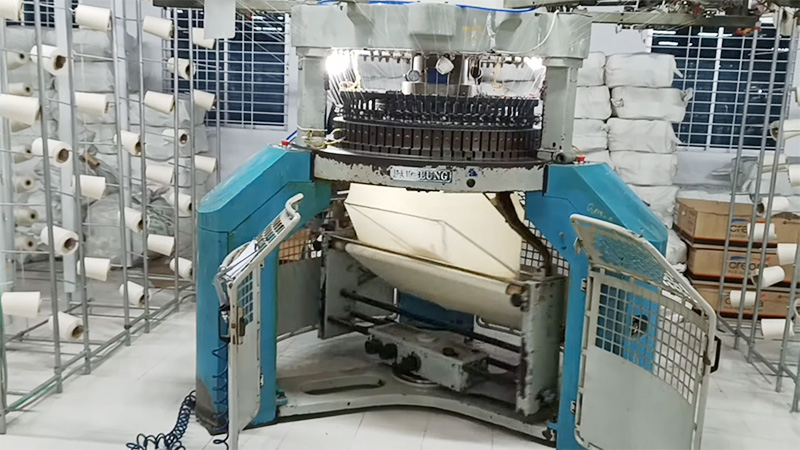
Cotton
Cotton is a natural fiber widely used in the production of double knit fabric. It is known for its breathability, comfort, and softness. Cotton fibers provide good moisture absorption and allow air circulation, making cotton double knit fabrics suitable for warm-weather garments and casual wear.
Polyester
Polyester is a synthetic fiber commonly blended with cotton or used on its own in double knit fabric. It offers excellent durability, wrinkle resistance, and shape retention.
Polyester fibers provide strength and stability to the fabric, making it long-lasting and less prone to shrinking or stretching.
Blends
Double knit fabrics can also be made from blends of different fibers, combining the desirable properties of each. Cotton-polyester blends, for example, offer a balance of breathability and durability.
These blends provide the comfort of cotton with the added strength and wrinkle resistance of polyester.
Other Fibers
In addition to cotton and polyester, double knit fabrics can incorporate other fibers such as rayon, nylon, acrylic, or spandex. These fibers can impart specific characteristics to the fabric, such as increased stretch, moisture-wicking properties, or enhanced texture.
The process of creating double knit fabric involves the use of two sets of needle beds set at an angle to each other. This arrangement allows the interlock stitches to be formed, creating the characteristic reversible structure of the fabric.
The choice of fibers and the knitting technique used contribute to the fabric’s properties, such as stretch, stability, weight, and texture.
What is Double Knit Fabric Used for?
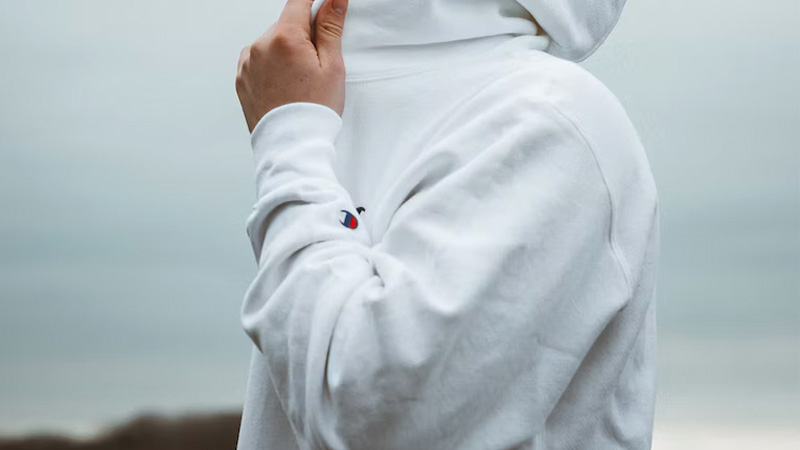
Tops
Double knit fabric is frequently used for creating tops such as T-shirts, tank tops, blouses, and sweaters. Its stability, stretch, and comfort make it ideal for these garments that require a good fit, shape retention, and ease of movement.
Pants and Leggings
Double knit fabric is well-suited for pants, trousers, and leggings. Its dense structure provides coverage and opacity, while its stretch allows for comfort and flexibility. Double knit pants and leggings offer a polished appearance and can be found in both casual and more formal styles.
Skirts and Dresses
Double knit fabric is a popular choice for skirts and dresses due to its stability, drape, and versatility. It can create a smooth, tailored look while offering comfort and ease of wear. Double knit skirts and dresses can range from casual everyday wear to more elegant and structured designs.
Jackets and Cardigans
Double knit fabric’s medium to heavyweight nature makes it suitable for creating jackets and cardigans. It provides warmth, structure, and durability, making it an excellent choice for outerwear. Double knit jackets and cardigans can have various styles, from casual zip-up hoodies to more structured blazers.
Activewear
Double knit fabric’s stretch and moisture-wicking properties make it suitable for activewear garments. It is commonly used for creating sports bras, athletic tops, yoga pants, and workout leggings. The fabric’s stability and ability to retain its shape provide support and comfort during physical activities.
Accessories
Double knit fabric can also be utilized for creating accessories like hats, headbands, scarves, and bags. Its versatility allows for a range of designs and styles in accessories that complement the garments made from double knit fabric.
How Do You Wash Double Knit Fabric?
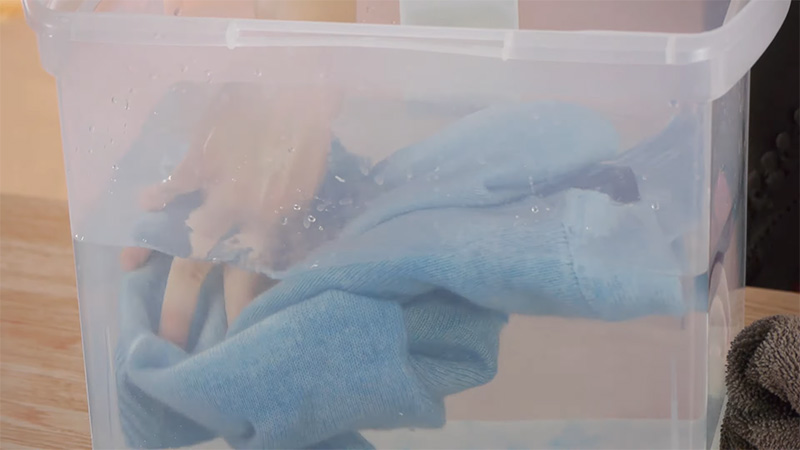
Handwashing
One of the safest methods to wash double knit fabric is by hand. Fill a basin or sink with cold water and add a mild detergent suitable for delicate fabrics.
Gently agitate the fabric in the soapy water, taking care not to twist or wring it. Rinse thoroughly with cold water to remove all detergent residue.
Delicate Cycle
If you prefer using a washing machine, select the delicate or gentle cycle with cold water for washing double knit fabric. Use a mild detergent formulated for delicate fabrics or a detergent specifically designed for knits. Avoid using harsh detergents or bleach as they can damage the fabric.
Test With Samples
For synthetic double knits, such as polyester blends, it is a good practice to test a small sample of the fabric before washing the entire garment. This will help ensure that the fabric reacts well to machine washing.
If the sample retains its shape, color, and quality after a cold water machine wash, you can proceed with machine washing the full garment.
Avoid Aggressive Washing
Regardless of the method you choose, avoid rough agitation or rubbing the fabric vigorously, as it can cause pilling, distortion, or stretching. Treat double knit fabric gently to preserve its appearance and shape.
Drying
After washing, avoid using a dryer for double knit fabric, as the high heat can cause shrinking, pilling, or damage to the fabric. Instead, lay the garment flat on a clean, dry towel or hang it on a padded hanger to air dry.
Avoid hanging the fabric on a line or using clothespins, as they can create unwanted stretching or marks.
Ironing
Double knit fabric typically does not require ironing, as it is resistant to wrinkles. However, if necessary, use a low heat setting and place a pressing cloth or a clean, thin fabric between the iron and the garment to prevent direct heat contact.
How to Care for Double Knit Clothes?
Read and Follow Care Instructions
Always check the care label attached to your double knit clothing for specific washing and care instructions. Manufacturers often provide guidelines tailored to the particular fabric composition and construction of the garment.
Washing
As a general guideline, it is recommended to wash double knit clothes using a gentle cycle with cold water. This helps prevent color fading, shrinkage, and damage to the fabric. Use a mild detergent specifically formulated for delicate fabrics or knits.
Drying
To avoid potential damage, it is best to air dry double knit clothes. Lay them flat on a clean, dry towel or a mesh drying rack. Avoid wringing or twisting the garments, as this can cause stretching or misshaping. If using a dryer, select the lowest heat setting or use the delicate/low-temperature cycle.
Ironing
Double knit fabrics are often resistant to wrinkles, reducing the need for ironing. However, if ironing is necessary, use a low heat setting or the synthetic fiber setting on your iron.
Place a pressing cloth or a clean, thin fabric between the iron and the garment to protect the fabric from direct heat contact.
Storage
When storing double knit clothes, ensure they are clean and dry. Fold them neatly and store them in a cool, dry place, away from direct sunlight. Avoid hanging the garments for extended periods, as this can lead to stretching or distortion.
Spot Cleaning
In case of minor stains or spills, it is recommended to spot clean the affected area promptly. Use a mild detergent or a specialized fabric cleaner. Gently blot the stain with a clean cloth or sponge, taking care not to rub the fabric aggressively.
Professional Cleaning
While double knit fabric is often safe for dry cleaning, it is still advisable to consult the care instructions or seek professional advice. If you choose to have your double knit clothes dry cleaned, inform the dry cleaner about the fabric type and any specific concerns to ensure proper handling.
How to Sew Double Knit Fabric?
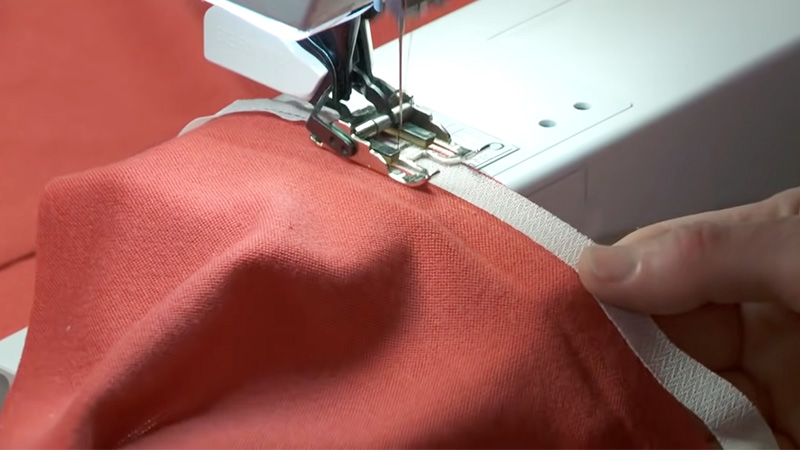
Use a Ballpoint or Stretch Needle
Double knit fabric is stretchy, so it’s important to use the right type of needle to prevent skipped stitches or fabric damage. Opt for a ballpoint needle or a stretch needle, as they are designed to penetrate knit fabrics without snagging or tearing the fibers.
Choose the Right Thread
Select a thread that has some stretch to accommodate the stretchiness of the fabric. Polyester or cotton-wrapped polyester threads are good choices as they offer both strength and flexibility.
Test Stitches and Tension
Before starting your main sewing, it’s a good idea to test different stitches and tension settings on a scrap piece of the double knit fabric. This will help you determine the optimal settings to achieve the desired stitch quality without causing excessive puckering or stretching of the fabric.
Use Stretch Stitches or Zigzag Stitches
Double knit fabric requires stitches that can stretch along with the fabric. Consider using stretch stitches, such as a narrow zigzag stitch or a triple stretch stitch, which will provide adequate flexibility and durability. Alternatively, you can also use a straight stitch with a slight elongation to allow for fabric stretch.
Use a Walking Foot or Differential Feed
To prevent the layers of double knit fabric from shifting or stretching unevenly, a walking foot attachment or a sewing machine with a built-in differential feed can be beneficial. These tools help feed the fabric evenly through the machine, resulting in more precise stitching.
Seam Finishing
Double knit fabric does not fray as easily as woven fabrics, but it’s still a good practice to finish the raw edges for a neater appearance and added durability. You can use techniques like serging/overlocking, zigzag stitching, or binding the seams with stretchy bias tape.
Press With Caution
Double knit fabric is sensitive to heat, so be cautious when pressing. Use a low heat setting on your iron or consider using a pressing cloth or a pressing mitt to protect the fabric.
If possible, press the fabric gently without applying too much pressure to avoid flattening or distorting the knit structure.
Try Using a Stabilizer
If you encounter difficulty sewing double knit fabric, especially with specific areas like hems or necklines, using a temporary stabilizer can be helpful. It can provide extra support and prevent stretching during the sewing process.
How Does Double Knit Fabric Impact the Environment?
Raw Material Production
The production of the fibers used in double knit fabric, such as cotton or polyester, can have varying environmental implications. Cotton production often involves extensive water usage, pesticide application, and land degradation.
On the other hand, the production of synthetic fibers like polyester relies on non-renewable resources and involves energy-intensive processes.
Chemical Usage
The dyeing and finishing processes of double knit fabric often involve the use of chemicals, such as dyes, bleaches, and chemical additives. The release of these chemicals into water systems can have negative environmental effects, including water pollution and ecosystem disruption.
Energy Consumption
The production of double knit fabric requires energy for various processes, including fiber production, weaving or knitting, dyeing, and finishing. The energy sources used for these processes can contribute to carbon emissions and climate change.
Water Usage
Double knit fabric production, especially for natural fibers like cotton, requires significant water usage throughout the cultivation, processing, and dyeing stages.
Excessive water consumption can strain local water resources, leading to environmental issues such as water scarcity and ecosystem degradation.
Waste Generation
The textile industry generates substantial waste, including fabric scraps, trimmings, and leftover dyes or chemicals. Proper waste management and recycling practices are necessary to minimize the environmental impact of this waste.
End-of-life Disposal
When double knit fabric garments reach the end of their lifecycle, their disposal can contribute to environmental pollution and waste. Landfilling or incineration of textiles can release greenhouse gases and other pollutants.
However, efforts to promote textile recycling and reuse can help reduce the environmental impact of disposal.
What Are the Advantages and Disadvantages of Double Knit Fabric?
Advantages of Double Knit Fabric
- No Stitches: One of the main advantages of double knit fabric is that there are no visible stitches on either side of the fabric. This gives it a seamless and polished appearance, making it suitable for garments and accessories where a clean finish is desired.
- Versatility: Double knit fabric is highly versatile and can be used for a wide range of clothing items, including tops, pants, skirts, dresses, jackets, and more. Its medium to heavyweight nature makes it suitable for both casual and more structured garments.
- Stability: Double knit fabric has a dense and stable construction, which allows it to maintain its shape well. It resists stretching and sagging, providing garments with good structure and durability.
- Reversible: Double knit fabric is reversible, meaning both sides of the fabric look identical. This can be advantageous when designing garments that may expose both sides, such as cardigans or reversible jackets.
Disadvantages of Double Knit Fabric
- Shape Distortion: Due to its high flexibility, double knit fabric can be prone to shape distortion. It may stretch or lose its original shape easily when subjected to excessive pulling or stretching. This can be a drawback, especially when precise fitting and structure are desired.
- Loosening of Yarn: In horizontally knitted double knit fabric, if one end of the yarn is pulled, it can cause the fabric to loosen sporadically along its length. This can lead to a looser and less secure fabric, potentially affecting its overall stability and appearance.
- Limited Breathability: Double knit fabric tends to have a denser and tighter weave, which can limit its breathability compared to lighter, more open knits or woven fabrics. This can result in reduced airflow and increased warmth, making it less suitable for garments worn in hot and humid climates.
- Fabric Weight: Double knit fabric is typically medium to heavyweight, which can be a disadvantage for those seeking lighter and more breathable fabrics. The weight and thickness of the fabric may not be ideal for certain applications or seasons where lightweight and airy fabrics are preferred.
Comparison Table Between Double Knit Fabric and Other Fabrics
| Property | Double Knit Fabric | Interlock Fabric | Rib Knit Fabric | Ponte Knit Fabric |
|---|---|---|---|---|
| Fabric Structure | Double-layered | Double-layered | Single-layered | Double-layered |
| Stretchability | Moderate to High | Moderate to High | High | Moderate to High |
| Appearance | Smooth and Polished | Smooth and Polished | Textured Ribs | Smooth and Polished |
| Weight | Medium to Heavy | Medium to Heavy | Light to Medium | Medium to Heavy |
| Warmth | Good Insulation | Good Insulation | Fair Insulation | Good Insulation |
| Wrinkle Resistance | Moderate | Moderate | Prone to Wrinkles | Good |
| Breathability | Moderate | Moderate | Good | Moderate |
| Durability | High | High | Moderate | High |
| Common Uses | Tops, Pants, Skirts, Dresses, Jackets | Tops, Dresses, Baby Clothing | Sweaters, Scarves, Cuffs | Pants, Skirts, Dresses, Jackets |
| Similar Fabrics | Ponte di Roma, Interlock Jersey | Ponte di Roma, Double Jersey | Interlock, Double Knit | Double Jersey, Interlock |
| Suitable Seasons | All Seasons | All Seasons | Spring, Autumn | All Seasons |
| Shrinkage | Minimal to None | Minimal to None | Minimal to None | Minimal to None |
| Care | Handwash or Delicate Machine Wash, Lay Flat to Dry | Handwash or Delicate Machine Wash, Lay Flat to Dry | Handwash or Delicate Machine Wash, Lay Flat to Dry | Handwash or Delicate Machine Wash, Lay Flat to Dry |
FAQs
Yes, double knit fabric can be suitable for activewear or athletic clothing. Its stretchability, durability, and moisture-wicking properties make it a good choice for comfortable and flexible sportswear.
Double knit fabric tends to be medium to heavyweight, which may not be ideal for very hot climates. However, lighter variations of double knits, such as interlock or lightweight ponte, can offer better breathability and can be suitable for summer garments.
Yes, you can sew double knit fabric with a regular sewing machine. However, it is recommended to use a ballpoint or stretch needle and employ appropriate stitch settings to accommodate the stretch and structure of the fabric.
Double knit fabric can be prone to pilling, especially if made from fibers like polyester or acrylic. Pilling is the formation of small fabric balls or fuzz on the surface. To minimize pilling, choose high-quality fabrics and follow proper care instructions.
Double knit fabric can be ironed, but it’s important to use a low heat setting and avoid pressing too firmly. It is advisable to use a pressing cloth or a pressing mitt to protect the fabric from direct heat.
Interlock fabric and rib knit fabric both fall under the category of double knits. Interlock has a smooth and polished appearance with two layers of knit, while rib knit has raised textured ribs running vertically. Interlock is generally more stable, while rib knit has more stretch and a textured surface.
To Recap
Double knit fabric is a versatile and durable material that offers several advantages. Its seamless appearance, stability, and versatility make it suitable for a wide range of garments and accessories.
With its medium to heavyweight nature, it provides good insulation and can be used for various seasons. Double knit fabric, such as interlock and rib knits, offers different textures and stretch capabilities to suit different design preferences.
While it has its benefits, such as wrinkle resistance and reversible properties, double knit fabric may also have drawbacks, including shape distortion and limited breathability.
However, with proper care and consideration, these drawbacks can be managed effectively. Understanding the characteristics, care instructions, and potential uses of double knit fabric allows for informed decisions when selecting and working with this fabric.
Leave a Reply